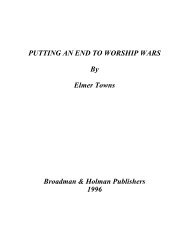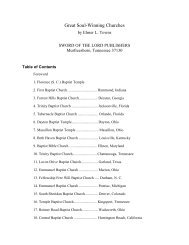A Journey Through The Old Testament - Elmer Towns
A Journey Through The Old Testament - Elmer Towns
A Journey Through The Old Testament - Elmer Towns
You also want an ePaper? Increase the reach of your titles
YUMPU automatically turns print PDFs into web optimized ePapers that Google loves.
the royal palace. Those returning were those who had a desire to return. Now they were<br />
experiencing the fulfillment of their dreams. As they traveled from Babylon to Jerusalem, they<br />
probably talked often with each other about their feelings. From time to time, they sang<br />
individually or as a group. Fifteen psalms called “<strong>The</strong> Psalms of Ascents” are thought to have<br />
been sung by the remnant as they returned (cf. Pss. 120-134). Though at least five of these<br />
psalms had been written by former kings of Israel, some may have been composed on the<br />
journey home or even in Babylon as the remnant prepared for the journey home.<br />
For over fifty years there had been no sacrifice in Jerusalem (since 586 B.C.). Seven<br />
months after leaving Babylon, the remnant was going to change all that. An altar was built in<br />
Jerusalem and burnt offerings were made as required by the Law of Moses. <strong>The</strong> first of the major<br />
feasts of Israel to be celebrated by the remnant after they returned was the Feast of Tabernacles.<br />
This annual feast in the fall was given by God to remind them of the forty years Israel had dwelt<br />
in tents. Before long other special days were honored and the evening and morning offerings<br />
were being offered regularly. “But the foundation of the temple of the Lord had not yet been<br />
laid” (Ezra 3:6). <strong>The</strong>re was no temple to symbolize that corporate worship was reestablished.<br />
<strong>The</strong>re were no walls around Jerusalem to symbolize the nation was reconstructed.<br />
In his decree urging the Jews to return to their homeland and build the temple, Cyrus had<br />
made a point of encouraging those Jews who chose not to return to contribute to the cause<br />
financially. <strong>The</strong> Persian king himself had contributed to the cause by returning to the prince of<br />
Judah the original vessels of the temple taken by Nebuchadnezzar. Even those who had returned<br />
had invested in the building of the temple financially. Still, the foundation of Israel’s second<br />
temple would not be laid for another eight months.<br />
“Now in the second month of the second year of their coming to the house of God at<br />
Jerusalem ... the builders laid the foundation of the temple of the Lord” (vv. 8, 10). As the people<br />
gathered in Jerusalem that day there was much singing. <strong>The</strong> theme of their song focused on the<br />
goodness of God and His enduring mercy (cf. Ps. 136:1). It was a day of mixed emotions for<br />
those present. Some who had seen the former temple realized this second temple would not be as<br />
spectacular as that built by Solomon. <strong>The</strong>y wept as they thought again of all they had lost. But<br />
for others, the building of this second temple was a step in the right direction. <strong>The</strong>y shouted<br />
loudly for joy as they saw the foundation laid, anticipating it would not be long before they could<br />
worship God in the temple. Between the weeping and singing, the mourning and shouting, it was<br />
difficult to discern all that was being said and done. Those who heard the celebration in the<br />
distance heard a loud noise, but it was not clear from the noise itself what was taking place in<br />
Jerusalem. All that was certain was that something had excited the Jews (Ezra 3:8-13).<br />
When the Jews returned to the land, they were not the only ones present. Soon the<br />
Samaritans were offering their assistance in building the temple. But Jeshua and Zerubbabel realized<br />
that the place of worship of the Jews should be built by the Jews, and so declined the offer.<br />
When the Samaritans’ offer of help was turned down, they were offended and decided to do what<br />
they could to discourage the work of rebuilding. <strong>The</strong>y hired counselors to argue against the<br />
project to the Persian authorities. Finally they convinced King Artaxerxes that allowing the Jews<br />
to rebuild the temple was to invite an insurrection on the part of a people with a long history of<br />
resisting foreign rulers. When a letter from Artaxerxes was received in Samaria agreeing that the<br />
Jews should be forced to cease building, the Samaritans “went up in haste to Jerusalem against<br />
the Jews, and by force of arms made them cease” (Ezra 4:23).<br />
For sixteen years, the work on the temple ceased. Despite the fact that Cyrus, a Persian<br />
monarch, had issued an immutable decree endorsing the reconstruction of Jerusalem and the
















